Sedum succulents belong to the Crassulaceae family. This collection of plants is commonly referred to as stonecrops. There are around 400 to 500 species in this family.
Sedum succulents fall into three distinct classifications. These are upright sedums, creeping sedums, and trailing sedums.
Most of these Sedum plants are easy to grow and require only minimal care. Because they are succulents, they should be allowed to dry out in between watering and most require around 4 to 6 hours of sunlight per day.
There are so many different sedum varieties to grow that collectors will never run out of a new one to add to their collection.
Let’s take a look at the top types of Sedum plants that are readily available and easy to grow.
Sedum album (Jelly Bean Sedum, White Stonecrop)
The Jelly bean Sedum is a low-growing plant that has a creeping habit. It’s also commonly called white stonecrop. The plant produces long stems with fleshy rounded leaves that are shaped like a jelly bean. Generally, the leaves are green but they may turn red depending on where the plant is grown and how much sunlight it gets.
White stonecrop can tolerate frost and is suitable for growing outdoors in USDA hardiness zones 6 to 8. It’s perfect for rock gardens as it loves to grow in rock crevices. It flowers in summer with white flowers on relatively tall stems.
Sedum acre (Common stonecrop, Gold moss stonecrop)
This succulent would make a stunning addition to any rock garden. It can spread for about 2 feet through underground rhizomes or tubers to produce a carpet of tight succulent rosettes that are quite small and dainty. The plant really comes into its own when it flowers. The flowers are quite large, bright yellow and star-shaped. In perfect conditions, they will cover the plant to give a stunning display of color.
Sedum adolphii (Golden sedum)
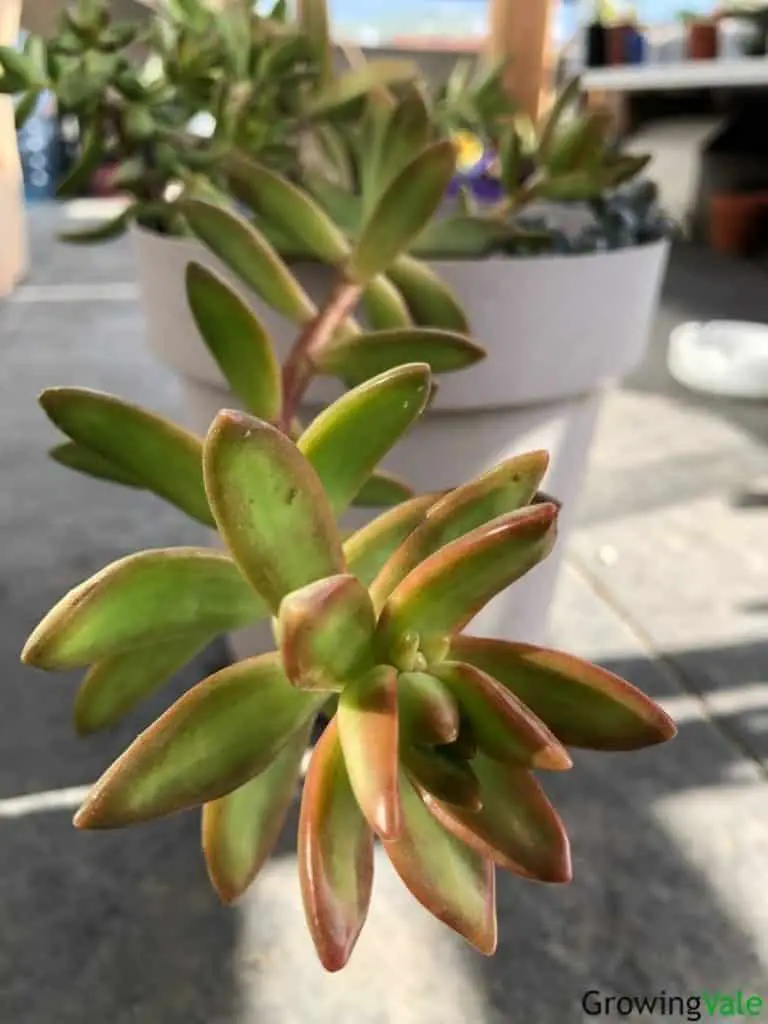
If you’re after a fast growing succulent, then Sedum adolphii fits the bill. The plant produces lovely rosettes of thick succulent leaves that are a light green with red tinges around the edges.
In late winter, the plant produces white or yellow star-shaped flowers. This would make a lovely colorful addition to your succulent collection. It’s not frost tolerant so is best grown indoors.
Sedum allantoides
This delightful succulent has thick, finger-like leaves that form rosettes. The leaves are a blue-green color and have a powdery covering. In summer, the plant produces greenish-white flowers, some of which can have red tips on the petals.
Sedum brevifolium (Short-leaved stonecrop)
This Sedum has small, round leaves arranged around long, trailing stems. The leaves can be blue-green and will turn red when exposed to sunlight. The leaves are covered with a white down making them look velvety.
The flowers appear on the ends of the stem and are white and daisy-shaped. They make a lovely contrast to the red and green foliage.
Sedum bulbiferum
This succulent ground cover produces long stems that can reach a length of 2 feet. It produces opposite leaves along the stems and rosettes at the ends of the stems. The yellow star-shaped flowers also appear at the ends of the stems.
Sedum burrito (Baby Burro’s Tail)
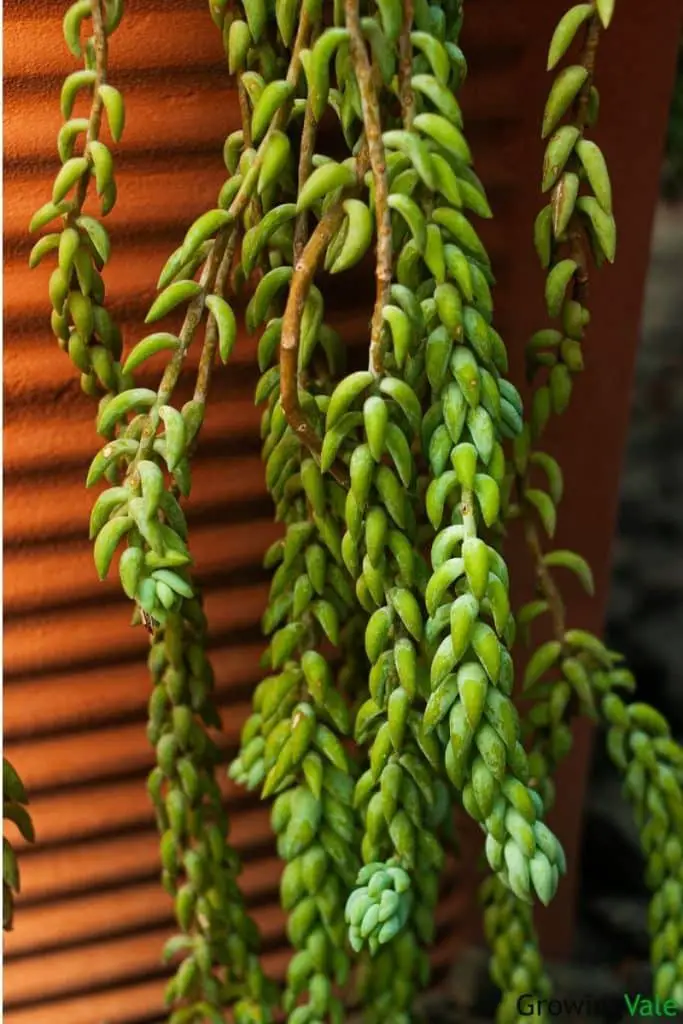
Sedum burrito is very similar to Sedum morganianum (Burro’s tail or donkey tail succulent), however, there appears to be a lot of conjecture as to whether the two species are related. However, Sedum burrito is a lovely trailing succulent that has long stems with small round, succulent leaves. The leaves are more rounded than those of Sedum morganianum.
This plant is ideal for growing in a hanging basket and can tolerate a little shade as long as it gets around 4 hours of sun daily. The plant produces small flowers in summer at the ends of the long, trailing stems.
Sedum caeruleum (Barbary Stones, sky stonecrop, baby-blue stonecrop, red-leaf, blue stonecrop, azure stonecrop)
This succulent has stunning ruby-red leaves and stems and gorgeous blue star-shaped flowers. In its native habitat, it grows as an annual and so, it might be quite rare to find this plant in cultivation. However, if you do manage to get hold of some seeds, it’s well worth the effort.
This plant is extremely drought-hardy and loves to grow in full sun.
Sedum clavatum (Tiscalatengo Gorge Sedum)
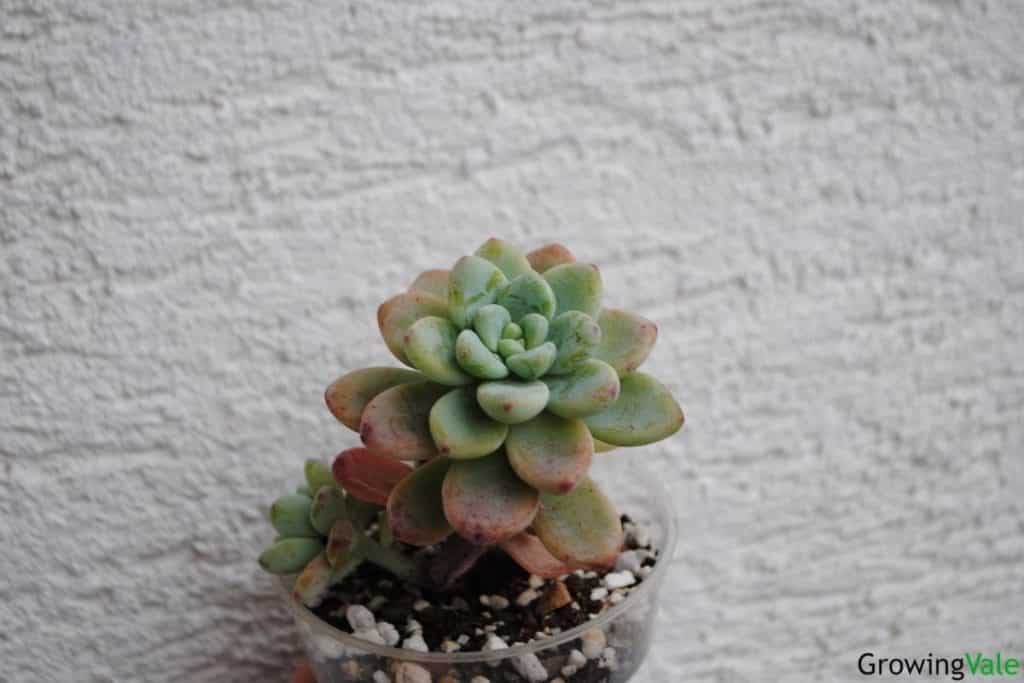
This is an attractive ground cover with blue-green leaves that form lovely small rosettes. The leaves are club-shaped and around 1 inch long. The flowers are small, white, and star-shaped. They can take on a pink hue with age. This succulent blooms in spring and the flowers can continue into early summer.
Sedum commixtum
This interesting succulent produces multiple stems that can be up to 1 foot in length. The leaves are arranged in rosettes and are very plump and jade green with rose-pink around the edges.
Sedum confusum
This is a pretty little ground cover with rosettes that appear along long, growing stems. The leaves can be dark to lime green but will exhibit a lovely pink blush when exposed to sunlight. As is typical for a lot of Sedum varieties, the flowers are yellow and star-shaped.
Sedum dasyphyllum (Thick-leaved stonecrop, Leafy stonecrop, Round-leaved stonecrop, Corsican stonecrop)

This is a spreading succulent that produces a low mat of tightly packed leaves. The leaves are powdery gray-green and covered in white, coarse hairs. When the weather cools down, the leaves turn a soft purple color.
The plant produces white flowers in summer in clusters on the ends of each stem. Due to its spreading nature, this plant is also great for growing in a hanging planter.
Sedum dendroideum
This Sedum grows as a small shrub and can reach a height of 3 feet. It has the most interesting succulent leaves that are arranged in open rosettes. The leaves are spathulate and grow upright but their tips point inward to the center of the rosette. These leaves are lime green in color with dark red around the edges.
Sedum emarginatum (Chinese stonecrop)
This succulent has lovely green paddle-shaped leaves that can turn a reddish-bronze when the weather gets cooler. It produces clusters of yellow star-shaped flowers that have green centers.
Sedum ewersii
This pretty succulent looks like it’s covered in green flowers. It produces a nice compact mound with rose-shaped rosettes that are a lovely blue-green color. In late summer, the plant produces star-shaped flowers that are rose-pink in color.
Sedum forsterianum (Rock stonecrop)
This is another type of Sedum succulent that produces tight rosettes of fleshy leaves on long stems. The leaves are so tightly packed that they form a cone shape rather than an open rosette. This is also a good ground cover plant or one to grow in a hanging pot.
The plant produces yellow, star-shaped flowers on 1-foot tall stems.
Sedum furfuraceum (Bonsai sedum)
This Sedum makes a very attractive container plant. It only grows to about 4 inches high and can spread up to around 1 foot. Each branching stem has tightly packed almost round leaves that are a deep jade in color. These can turn a reddish-purple when exposed to bright light. White flowers are produced in semi-clusters on the ends of each stem.
Sedum hispanicum
This low-growing succulent only grows to about 6 inches in height. It has small, tightly packed rosettes of pencil-thin leaves. These start out as being blue-green in color but can turn a dark red when exposed to direct sunlight. The plant produces clusters of small, white or pale pink flowers with bright red centers in late spring to summer.
Sedum litoreum (Coastal stonecrop)
This low-growing succulent only reaches a height of about 6 inches. It produces small rosettes of obovate leaves that are bright green. The plant produces star-shaped flowers that are pale yellow in color.
Sedum lucidum (Giant Jelly Bean)
This succulent grows as a shrub but only to about 7 to 8 inches tall. It produces distinctive rosettes of fleshy leaves that are bright green with red edges. The leaves have a lustrous sheen when grown in bright light.
In winter, this plant produces huge clusters of small white flowers with bright yellow centers.
Sedum mocinianum
This is a very attractive Sedum that has glabrous, fleshy leaves that are densely covered with white hairs. These give the plant a kind of fuzzy appearance. The leaves grow on hanging stems that can reach a length of 32 inches and are either arranged in dense rosettes or spirals.
The plant produces small, white flowers in winter that are quite unique with their bright red pistils.
Sedum moranense (Red stonecrop)
Red stonecrop is a lovely upright succulent that only grows to around 6 inches tall. The upright stems have small succulent leaves that are bright green but turn bright red when the temperature drops. During midsummer, the plant produces delicate, white flowers at the ends of the stems.
Sedum multiceps (Miniature Joshua tree, Baby Joshua tree, Pigmy Joshua tree)
When grown in a pot, this succulent really looks like a collection of miniature trees. It produces a collection of woody stems that have tightly packed rosettes of fleshy, green leaves on the tips. The leaves are quite slender and have a dark green color.
During summer, yellow star-shaped flowers appear on the tips of the rosettes.
Sedum nussbaumerianum (Coppertone stonecrop)
This is another highly attractive succulent that produces lovely symmetrical rosettes. When grown in partial shade, the leaves are yellowy-green. However, when exposed to full sunlight, the leaves turn a rosy-gold color.
In late winter, the plant produces fragrant white clusters of flowers on short stems that grow from within the rosette.
Sedum oxypetalum (Dwarf Tree stonecrop)
This is one of the upright growing Sedums. It has a stout trunk with upright stems that exhibit a papery peeling bark. This plant can grow to a height of 4 feet in certain conditions. The succulent leaves are typically leaf-shaped and green in color. The flowers appear in summer and are fragrant. They are star-shaped and pale yellow in color with reddish or orange centers.
Sedum pachyphyllum (Many fingers, Succulent beans, Jelly bean plant)
This attractive succulent grows upright stems that have rosettes of thick jelly bean-shaped leaves pointing upward. The leaves are a pale green but their tips are orangy-red so they give the impression of resembling fingers.
The plant flowers at a young age. It produces starry yellow flowers with long tapered petals.
Sedum palmeri (Palmer’s Sedum, Mexican hens and chickens, Palmer’s stonecrop)

The interesting thing about this Sedum is that it’s widely grown on balconies in Italy. This means that in springtime, residential buildings are adorned with sprays of yellow flowers.
The plant forms small rosettes of fleshy leaves that are lime green and edged with a rosy red. These rosettes grow on erect or reclining branches as the plant spreads and grows. The flowers appear on stems at the end of each rosette and are arranged in clusters.
Sedum reflexum (Blue spruce stonecrop)
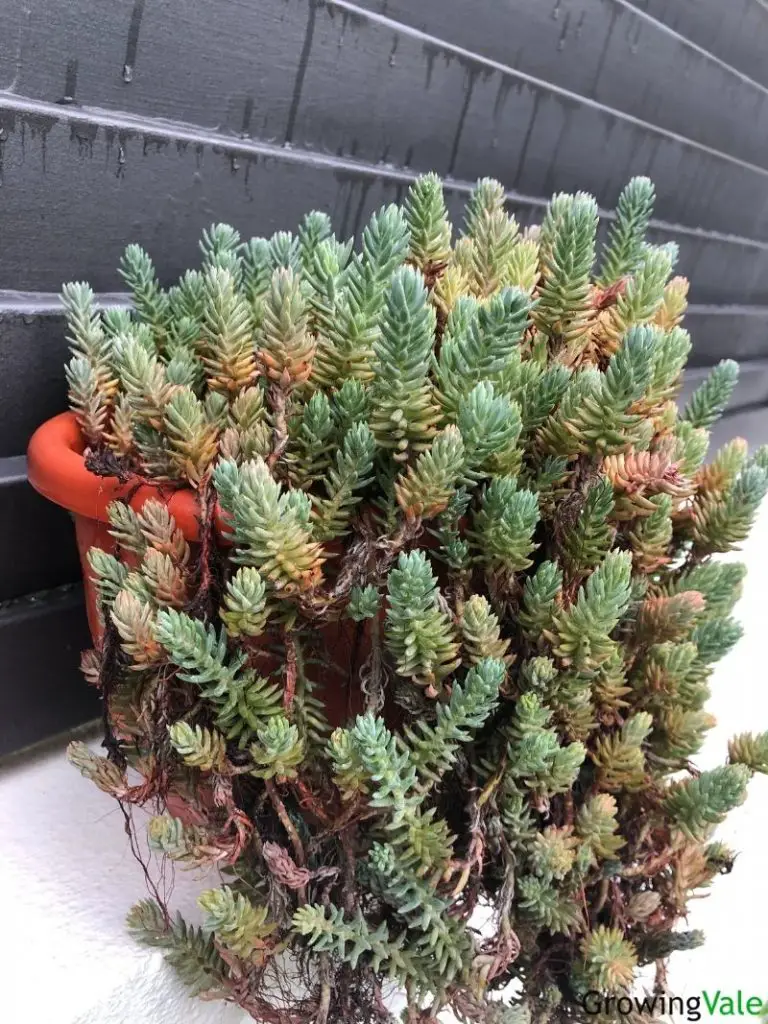
This is a low-growing succulent that can spread to cover an area around 2 feet wide. Therefore, it makes an excellent ground cover in a rock garden. It produces upright stems that have needle-shaped succulent leaves.
Sedum sediforme (Pale stonecrop)
This succulent has an interesting growth habit. It produces many short stems that have fleshy leaves on them but are non-flowering. The flowering stems are long, erect, and become woody toward the base.
Each flowering stem produces a cluster of pale yellow blooms that are star-shaped and uncurl to become almost flat.
Sedum sexangulare (Tasteless stonecrop, chain stonecrop, Six-sided stonecrop, Watch-chain Sedum)
This is another succulent that looks spectacular when it’s in bloom. The plant produces short, upright stems that are encircled with fleshy green leaves. In early summer, from the tips of these stems grow clusters of yellow star-shaped flowers.
This plant would add a lovely sea of color to any rock garden or potted succulent collection. It spreads rapidly and is super easy to propagate.
Sedum spathulifolium (Broad-leaved stonecrop, Pacific stonecrop)
This Sedum produces rosettes of leaves at the tips of short stems. The rosettes are green and have a chalky covering. Depending on the temperature and sunlight, the leaves can become a dusty rose color.
When the plant blooms, it produces clusters of bright yellow flowers at the tips of the stems. The flowers are also sweetly fragrant. This is a spreading succulent that produces rhizomes underground
Sedum spurium (Two-row Sedum, Caucasian stonecrop)
If you’re looking for a fast-growing succulent to form a dense ground cover, then Sedum spurium is a variety you should try. The plant spreads by creeping stems that form roots along the ground. Along these stems grow rosettes of small green fleshy leaves.
In late summer, the plant produces rounded clusters of pink, red or white flowers that are star-shaped. This plant is widely cultivated and there are numerous different cultivars available.
Sedum stahlii (Mexican Sedum, Coral bells)
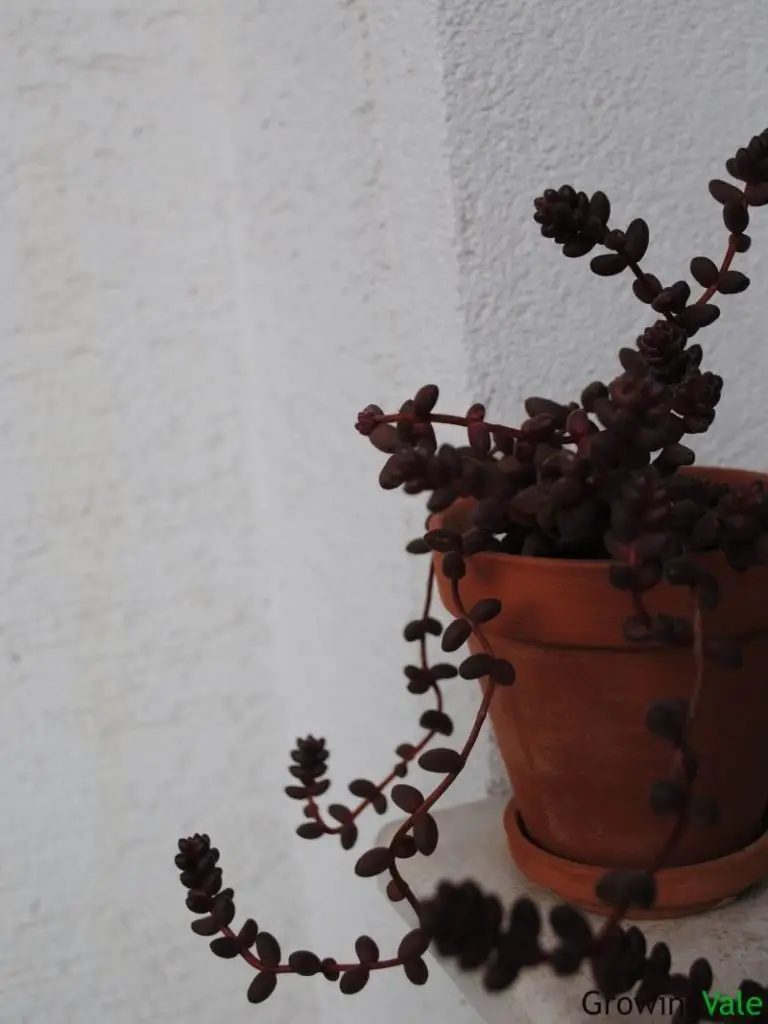
This Sedum is just perfect for growing in a pot. It has thick egg-shaped leaves that are arranged opposite on short stems. The leaves do drop off quite easily but will propagate readily if they drop into the soil. They are green in color but often turn red when exposed to full sunlight.
Flowers are produced at the tips of the stems. These are star-shaped and bright yellow.
Sedum tetractinum (Chinese stonecrop, Fish-scale sedum)
This is another spreading ground cover succulent. It spreads by runners and forms a thick mat of overlapping foliage. The bright green leaves form small rosettes along the reddish runners. During the cooler weather the leaves turn a lovely burgundy color.
In late summer, the plant produces lovely star-shaped flowers that are yellow in color.
Sedum treleasei
This small-growing succulent has tight rosettes of blue-green leaves that are quite plump. Once the plant matures, the leaves can have pink or yellow edges. This succulent grows to about 1 foot in height and is a perfect specimen for growing in pots.
It produces clusters of yellow flowers from the tops of the rosettes.
Sedum ‘Vera Jameson’
While most Sedums on our list produce yellow flowers, this beauty is a hybrid and produces the most gorgeous pale to bright pink flowers in large clusters on the ends of the stems. The fleshy leaves of the plant are a blue-green color but develop a reddish-purple shade as they mature.
See more types of succulents you can grow here.

